Alaska Fish & Wildlife News
November 2025
Tracks of Alaska Animals
A New Guide for Educators

On an early fall day in Interior Alaska, an animal moved across a wash of silt and soil in a drainage of Denali National Park. Do you know who made this track?
On a regular basis, Mike Taras poses the question, “What animal left these tracks?” He hosts a popular Facebook feature called “Track Tuesday” with pictures of tracks, and offers hints and clues to help answer the question. He often features other wildlife signs - evidence of browsing, scat, and animal "signposts" marking territories.
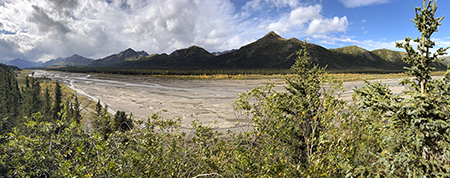
Since 2019, these wildlife tracking posts have engaged thousands of people in Alaska (and beyond) interested in identifying the tracks and sign they find in their backyards, on local trails, and while trapping, hunting, fishing, and hiking in the backcountry.
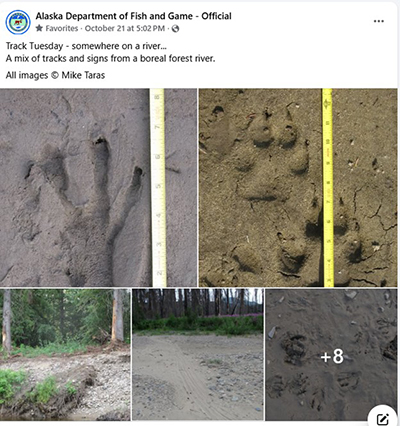
Mike has been the ADF&G Wildlife Education Specialist for the Interior and Eastern Arctic region of Alaska for 23 years. He’s an avid tracker and studies and teaches wildlife tracking. His interest began as a child, using the tracking field guides available at the time. As an adult he discovered CyberTracker North America, an organization that certifies wildlife trackers through a rigorous evaluation system, and 17 years ago he began attending trainings, and track, sign and trailing evaluations throughout the U.S. and in South Africa. Mike has helped bring CyberTracker evaluations to Alaska – in fact, the mystery track featured in this article was from an evaluation in Denali this past August.
Mike contributed to many of the resources that the ADF&G Wildlife Education and Outreach Program offers for teachers and students. Animal tracks were the theme of the 2012 issue of Alaska’s Wild Wonders, the annual student wildlife magazine produced by the ADF&G Wildlife Education team. He’s also worked on the wildlife education kits that are available in regional ADF&G offices across the state. Some of the kits, such as the Alaska mammal furs, Alaska mammal skulls, and the Bears of Alaska, include a guide for educators, but the Tracking kit did not – until now.
Tracks of Alaska Animals - A Guide for Educators
“I’ve thought about a guide for educators in Alaska for several years,” he said.” We had the kit, but were missing a thorough, systematic overview of Alaska animal tracks, including lessons for educators to use in engaging their students in the learning process”.

The guide complements the contents of the Tracks kit and provides structure for use; it is also a standalone resource for teachers to help students learn about animal tracks. It is not a field guide.
“It isn’t something you take into the field or look through with images of tracks to identify tracks,” he said. Instead, it teaches the fundamentals of track characteristics and groups similar tracks and animal families together. “Learning these fundamentals helps students ask the right questions, which can eventually lead them to a section of field guides for more specific information to identify a species.”

Questions such as: How many toes does this track have? Do the front and rear feet have the same number of toes? What size are these tracks? What are the toe pads shaped like? What gait does the track pattern indicate the animal was moving in?
“I see the desire and fascination people have for learning animal tracks and sign,” Mike said. He is particularly excited for this guide to empower educators to engage and develop the inquisitive nature of their students – and to learn along with them.
While Mike provided much of the inspiration and expertise necessary to make a tracks educator guide possible, it took the entire Wildlife Education and Outreach Program team to get it from a good idea to a published resource. Creating an educator guide is comparable to publishing a book. It required extensive knowledge of the subject matter, the skill of design, the use of publication software, and a grasp of teaching concepts.
A brave and talented college intern in Juneau working with the Wildlife Education and Outreach Program, Lindsay Meyer, volunteered to take on the bulk of this daunting project. She worked part-time for more than a year with a steering committee to compile and layout the content.
“It felt meaningful and rewarding to help bring a tracks guide to life,” she said. “The most memorable part was the excitement and enthusiasm surrounding the project.”
After an additional year of edits and finish work, Tracks of Alaska Animals: A Guide for Educators was published this past summer, just in time for the 2025-2026 school year.
“I would love to hear how educators adapt and use the guide for their students, in their classrooms,” Lindsay said. “I hope it helps students feel more knowledgeable about and connected to the incredible wildlife in Alaska.”
The pdf is available for free on the ADF&G website – and while it is focused on educators, it is available to anyone that wants to learn about tracks. The link is at the end.
Returning to the Mystery Track
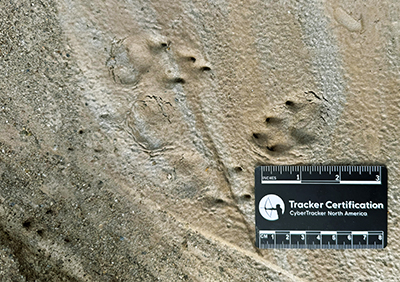 “Most people that see these tracks in soil for the first time have no idea what they are,” Mike said. “They look like nothing else. That is a good and bad thing. Once you know the characteristics for this track family, you will never mistake the tracks again.”
“Most people that see these tracks in soil for the first time have no idea what they are,” Mike said. “They look like nothing else. That is a good and bad thing. Once you know the characteristics for this track family, you will never mistake the tracks again.”
Size is one obvious clue to all tracks, but these tracks do not appear as large in soil as they do in snow. In addition, the size difference between the front and hind feet of this animal is minimized in the soil as only the claws are showing.
In these tracks, four claw marks show up, but not really any toes. That is because this animal does not have toe pads like other mammals. The tracks have a very pointy shape as indicated by the leading claw. Another clue to the animal that made these tracks is that they are asymmetrical, and more importantly, the claws appear in an upside-down J shape with the point/leading claw forward and the top of the J-shape of the claw on the outside of the track (see first and second photo of this article). If the track is in fine silt, you will also see the fine hairs that cover the bottoms of the feet of this animal (see first photo of this article).

Thumbing through the Tracks of Alaska Animals guide, you might find another clue if you read the following line on page 15: “_________...have five toes on the front feet (although the small inner toe is reduced and normally doesn’t show up in tracks)”, meaning that in tracks, the front and hind feet both show four toes.
If that isn’t enough to determine the animal, there is more evidence by looking at sets of tracks. They are in groups of four with an obvious space between groups, which means a bound or a gallop in this case. These tracks usually have two feet in line with each other (front feet) and two feet ahead of the fronts (hinds) which are more side by side or parallel with space between them.
In the picture showing the complete track pattern in the silt, the hind feet are not side by side and have little space between them and the group of tracks is stretched long. This indicates that the animal was traveling at a high rate of speed. More so than their normal bounding gait (see page 6 of the guide for more about gaits and track patterns).
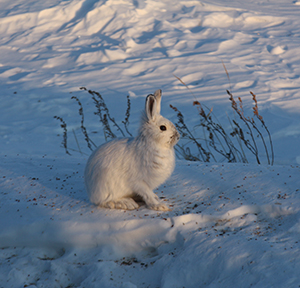 Our mystery tracks are from a snowshoe hare! Snowshoe hare winter tracks are also shown above in the snow for comparison. For most people, these tracks are far more recognizable in the snow. Mike concludes, “Once you know all the fundamentals, and you know about the wildlife in your area, you should be able to come to a conclusion based on the evidence on hand”. But tracks are often messy and incomplete, so the more you know the better your ability to come up with a correct identification.
Our mystery tracks are from a snowshoe hare! Snowshoe hare winter tracks are also shown above in the snow for comparison. For most people, these tracks are far more recognizable in the snow. Mike concludes, “Once you know all the fundamentals, and you know about the wildlife in your area, you should be able to come to a conclusion based on the evidence on hand”. But tracks are often messy and incomplete, so the more you know the better your ability to come up with a correct identification.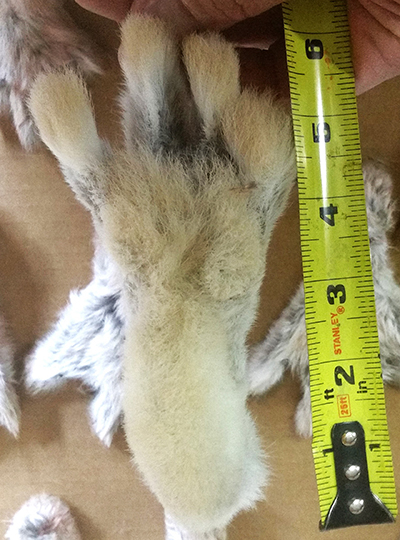
Right: The bottom of a snowshoe hare's foot, showing the hair on the footpad that is visible in the silty track. Only the front half appears in that track, the heel did not touch the ground. It's more likely to show up in snow, which is why the hare's track would look bigger (longer) in snow.
More resources
The ADF&G Wildlife Education and Outreach team hopes this new guide will inspire educators, students, and anyone interested in learning more to get outside and practice identifying animal tracks.
Tracks of Alaska Animals: A Guide for Educators
Alaska Department of Fish and Game Official Facebook page
Tracking Certification CyberTracker of North America
Tracks issue of Alaska’s Wild Wonders
Other ADF&G Curricula Guides
Subscribe to be notified about new issues
Receive a monthly notice about new issues and articles.
